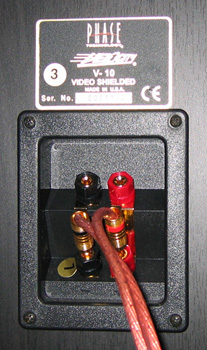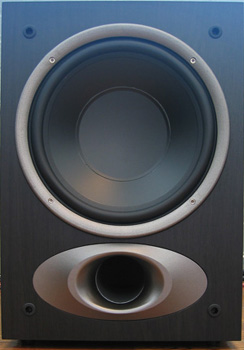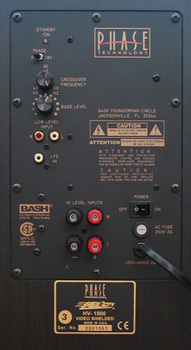Introduction
Phase Technology is a brand I have been interested in for quite some time
due to their reputation for high value and performance. Founded in 1978 by
William Hecht, Phase Technology has a long history of innovation, including
the patent for the soft dome tweeter.
I had a chance to meet with Bill and
his son, Ken, the company's president, at CES this year and talk to them
about the Velocities and some of their other products. They were both very
excited about the Velocities, and their demo for me at CES wet my appetite
for a full review. It was impressive for me to see the passion and
knowledge these men have for speaker design.
The Velocity series is a new value-oriented line for Phase Technology. They sent me a 5.1 system based on the V-10 tower mains ($750/pr), the
V-6 center ($250/ea), the V-4 bookshelf surrounds ($280/pr), and the HV-1000
subwoofer ($475/ea) in a very black finish.
The line
also includes another tower, the V-12 ($1200/pr), another bookshelf, the V-8
($450/pr), two more subs, HV-800 ($375/ea) and the HV-1200 ($600/ea), and a
dipole/bipole surround, V-Surround ($450/pr).
The Design
When I was unboxing the Velocities, I decided to start with the biggest box
which contained the V-10 towers. The V-10's stand 40.5" tall, 8.5"' wide, and 12" deep.
They feature an outrigger style base with sturdy spikes to keep everything
nice and stable. The V-10's are a two-way ported design featuring a 7" Vapor
Deposited Titanium (VDT) woofer and a 1” soft dome tweeter.
The drivers each
sit in their own baffle unit made with a high density resin to reduce
vibration. Sitting right below the drivers is a largish front port, which is
a nice touch that should help the placement options.
The entire Velocity
line features Phase Technology's “Absolute Phase” crossover, which is
designed to keep the drivers acoustically and electrically in phase and to
maintain vertical axis dispersion, which results in an even sound if your
ears are either above or below the plane of the tweeter.
Aesthetically, the
V-10's and the rest of the speakers are very pretty, with sculpted baffles and
the shiny VDT woofers.
Moving on to the next box yielded the V-6 center
channel featuring the same tweeter as the V-10, flanked by a 5.25" VDT
woofer and a 5.25" VDT passive radiator in a sealed box enclosure. The V-6
can be used either vertically or horizontally and can also be used as a main
speaker. At 7" tall, 18"' wide and 8.75" deep, the V-6 should have no
problem fitting into most home theater setups either vertically or
horizontally.
For the surrounds, Phase Technology supplied the V-4
bookshelves, a two-way rear ported design that features the same tweeter and
5.25" VDT woofer as the V-6. The bookshelves are relatively compact at 11"
tall, 7” wide and 9.25” deep.
Finally, there is the HV-1000 subwoofer. The
HV-1000 is based around a 10” mica/graphite woofer, driven by a 250 watt
amplifier in a front ported enclosure. The HV-1000 is relatively compact at
17" tall, 11.75” wide and 16” deep and quite light at 28 pounds. For
connections, the HV-1000 has speaker level inputs and outputs, line level
inputs, and an LFE input.
The controls on the HV-1000 consist of volume and
crossover frequency knobs and a 00-1800 phase switch. All of the Velocity
speakers feature removable grilles. The V-4, V-6, and V-10 all have nice gold
plated binding posts, with the V-10 sporting two pairs for bi-wiring or
bi-amping.
 Setup
Setup
I placed the Velocity speakers in an ITU style layout with the mains at 300 from the center and the surrounds at 1100. I did not toe in
the V-10's as they had plenty of center fill without it, and this helped to
expand the soundstage. All speakers were placed at ear level and had their
grilles removed on the recommendation of Phase Technology.
The V-6 center was
placed horizontally, with its tweeter slightly below the tweeter of the main
speakers. The speakers were driven the entire time by a Pioneer Elite VSX-49TX
receiver and a DV-47A DVD-Audio/SACD player. I crossed over the V-6's and
the V-4's at 80 Hz, and I experimented with running the V-10's full range and
crossed over at 80 Hz.
Listening
The Velocities gave me an early indication of their performance when I was
tuning in the system and I decided that it might be fun to watch the U2:
Elevation Tour concert DVD. I was getting into the disc and was pretty
impressed by the dynamics and the powerful bass that this system could
produce, when I faintly heard a knock at my door. It seems that my neighbors
don't appreciate U2 as much as I do. The system was just so clean and
enjoyable at high SPL that I didn't back off like I normally would. This
set the tone for some of the finest attributes of the system, deep bass
extension from the V-10's and excellent dynamics all around.
 With
these attributes in mind, I decided to start running some serious DVD test
scenes through the system. I had heard my fair share of very impressive
demos at CES, and I thought it would be interesting to see how the Velocity
system stacked up. I started out with Pirates of the Caribbean, something
that was being used everywhere at CES to showcase all kinds of speakers and
electronics. The Velocities handled the movie in stride, producing dynamic
and engaging soundscapes. While watching Pirates or any of my other
material, I never found the Velocities bright or fatiguing, a major
accomplishment in a reasonably priced speaker.
With
these attributes in mind, I decided to start running some serious DVD test
scenes through the system. I had heard my fair share of very impressive
demos at CES, and I thought it would be interesting to see how the Velocity
system stacked up. I started out with Pirates of the Caribbean, something
that was being used everywhere at CES to showcase all kinds of speakers and
electronics. The Velocities handled the movie in stride, producing dynamic
and engaging soundscapes. While watching Pirates or any of my other
material, I never found the Velocities bright or fatiguing, a major
accomplishment in a reasonably priced speaker.
I continued my action movie
kick by watching X-2 and Super Speedway. Both movies sounded excellent with
dynamic and coherent presentation. The timbre matching between the
different speakers was excellent, with seamless pans across the front stage.
I also spent some time sitting out of the sweet spot, and the off-axis
response was very good, with minimal degradation in quality. Moving my head
above and below the plane of the tweeters also had less effect on the sound
than I normally find.
One of the key things I noticed throughout all of this was how much bass the
V-10's put out. The speakers are rated at being 3 dB down at 35 Hz, and my in
room response test confirmed this. On many of the movies I watched, the V-10's
were overpowering the HV-1000, such that I was interested to see how the
system would perform without a sub. After disconnecting the sub, I fired up
chapter 16 of Titan AE, the “Ice Field”. There is a ton of low bass
information in this scene, and if played at a reference level, it should
really be shaking your room. The V-10's delivered admirably, producing
detailed, tight and deep bass.
I moved on to the opening scene of Star Wars
Episode II: The Clone Wars. The ship's engine noise in this scene gives all
but the very best subwoofers a run for their money, so I wasn't expecting
any miracles from the V-10's. The sound was breaking up at louder volumes,
but the V-10's performance was still impressive and exceeded my
expectations.
 I
moved on to music with a selection of different multi-channel SACD and
DVD-Audio recordings. One of my favorites here was the new SACD remastering
of The Who's Tommy. With this excellent material, the Velocities rocked my
house for days, continuing to show their strong traits of excellent dynamics
and solid bass extension. The imaging on this multi-channel material and
other stereo material was competent, but not extraordinary.
I
moved on to music with a selection of different multi-channel SACD and
DVD-Audio recordings. One of my favorites here was the new SACD remastering
of The Who's Tommy. With this excellent material, the Velocities rocked my
house for days, continuing to show their strong traits of excellent dynamics
and solid bass extension. The imaging on this multi-channel material and
other stereo material was competent, but not extraordinary.
Tonally, the
V-10's and the V-6 were always right on, never getting bright or fatiguing
and displaying a natural timbre on instruments and voices. I've
heard more detailed and transparent speakers than the Velocities, but
nothing in their price range that could keep pace dynamically or offer the
kind of bass extension they have.
Finally, to round out my listening, I moved the V-4's up front to see how
they performed as main speakers. I started out listening to them
without a sub. The V-4's offer 60 Hz extension which,
while far from full-range, is very listenable for most material. I began
by listening to Saturday Traffic from Copland's The City (Telarc CD-80583),
and I was instantly impressed by the V-4's, as they offered the natural tonal
character of the V-10's with slightly greater transparency in the treble and
midrange. This is probably due to the smaller woofer and baffle of the
V-4's.
My old wind band standby, Gustav Holst's Second Suite in F,
Fantasia on the Dargason (Telarc CD-80038) provided an interesting
comparison between the two speakers. At the beginning of the movement, the
V-4's took a narrow lead by providing a more open and natural sound to the
alto saxophone and clarinet, but as the movement progresses and builds in
complexity, the V-10's began to take over. The bass drum hits and the tuba
solo at the end of the movement really let the V-10's shine. At the end of
the day, both speakers did an excellent job with this track. Adding in the
HV-1000 to support the V-4's made for an excellent combination with a nice, seamless blend between the two when crossed over at 80 Hz.
 Conclusions
Conclusions
Obviously, I was very pleased with the Phase Technologies
Velocity speaker system. The Velocities' sound quality on both movies and
music was hard to fault, and while it may not be the best at any one aspect
of speaker performance, their balanced qualities make their overall sound
very enjoyable.
The V-10's are great main speakers, and at $750/pr an
excellent
value, providing top notch dynamics and extension. If you want high quality
tower speakers under $1000/pr for both movies and music, the V-10's are a
good choice.
The V-6 was impressive as a center for both movies and multi-channel music and is also an excellent value at only $250. It is a no-brainer choice if you are building a multi-channel Velocity system. The V-4's
are another excellent speaker and at $280/pr they are priced quite
reasonably for a bookshelf of their size and type. I have no problem giving
them an unqualified recommendation if you want to round out your
all-Velocity system with the V4's as surrounds. I also really liked the V-4's as
small main speakers, and they worked particularly well in my system, but the
competition in this price bracket is fierce, with many high quality
contenders. You'll have to decide whether the V-4's are right for your room
and your setup.
Taken on its own, the HV-1000
is a decent value for a 10” sub at $475. But, if you're buying the V-10's, you are going to
need a bigger subwoofer, and if you really want the sub to add appreciably to
the sound, it is going to need to have output into the mid-20 Hz range.
However, if you are building a system around the V-4's, it would be a superb
choice for a subwoofer. With these considerations in mind, I can easily
recommend Phase Technology's Velocity speaker system for anyone who wants a
well-balanced speaker setup for both movies and music.
- Matthew Abel -